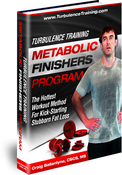Using Your Workouts to Increase Your Metabolism
 If you are a fan of exercise, you probably have heard about or are familiar with metabolic training. This type of workout differs from the more traditional forms as the goal is to speed up your metabolism so your body becomes a lot more efficient in breaking down your food so all the nutrients can go into the body and form new tissue along with maintaining itself. It is basically a conversion of food into energy. Some of the food will be used immediately and some will be stored in your body’s tissue.
If you are a fan of exercise, you probably have heard about or are familiar with metabolic training. This type of workout differs from the more traditional forms as the goal is to speed up your metabolism so your body becomes a lot more efficient in breaking down your food so all the nutrients can go into the body and form new tissue along with maintaining itself. It is basically a conversion of food into energy. Some of the food will be used immediately and some will be stored in your body’s tissue.
There are ways to boost your metabolism like eating certain foods, drinking specific beverages as well as eating every several hours throughout the day. Exercise is another one of these effective ways and you do not have to be an advanced or professional exerciser to reap the benefits of a workout program that targets your metabolism. In fact, if you who want to lose weight or get healthier, these metabolism-specific workouts are what you should be doing.
What Exercise Is and Is Not
Everyone knows that exercise is any activity that gets your heart rate up. It can be running, bicycling, swimming—even playing tag with your kids. However, when it comes to metabolic training, this type of exercise will result in nothing more than boredom. If your goal is to speed up your metabolism, this type of exercise is not going to come close to doing the trick.
A good exercise program needs to incorporate more than just your heart getting a workout. It needs to utilize your entire body. This means adding weight and/or resistance training into your workout. It also means taking your cardiovascular workout up several notches—that run needs to be a sprint, that bike ride needs to have more hills and the swimming needs to be faster. In a nutshell, you need to perform these activities at your maximum potential and then push further from there. That is what real exercise is all about.
Weight Lifting
Probably one of the most misunderstood forms of exercise is weight training. Women shy away from it because they either do not know what they should be doing or they are fearful that they will bulk up. Men love to weight train from the standpoint of looking good, getting stronger and bragging about how much they can bench press. But weight training has a whole lot more to offer than bragging rights and a toned physique.
Building muscle gives your metabolism a boost. How? For every pound of muscle you have, you will burn approximately six calories a day (fat only burns two calories a day). That may not sound like a lot but consider that number over a week, a month or a year. It will start to add up. Plus, after a really good weight training session, your metabolism will get an automatic jolt trying to help your muscles recover from all your hard work.
Now that you know what to do, you need to put it all together to create a supercharged metabolic training program. This is most effectively done through circuit training where you will use all the major muscle groups and take minimal amounts of rest. Your heart rate will stay elevated through most of the workout as you continually go from one exercise to another with little recovery time.
What is great about this type of training, aside from the metabolism boost, is that you can design your circuit any way you like. Just make sure to incorporate both cardiovascular exercises and resistance training. Your circuit can have six, seven, eight, nine or ten different exercises. The key is to keep moving between each one with no rest. A brief rest will come after you complete one round before you hit the circuit several more times.
When creating a workout like this, you want to choose exercises that will give you the most bang for your buck. That means each cardiovascular exercise should be a high intensity one like burpees, mountain climbers or jumping jacks. Your weighted exercises should be a bit more complex than the standard seated bicep curl, for example. After all, you are looking to kick start your metabolism and sitting down is not the way to do it.
The most effective exercises are those that use both the upper and lower body simultaneously. A good example of such an exercise is a push press—a squat with an overhead shoulder press. Another example is an alternating one-arm row in a push-up position (you can even throw push-ups into the mix for even more of a burn). These are just two of many exercises where you can work more than one muscle group at the same time. Another added benefit—these types of exercises really elevate the heart rate.
Where Do You Start
To create a workout that targets your metabolism, choose six to ten exercises and make sure you have resistance training exercises along with some cardiovascular movements in the mix. Set the amount of reps you want to do for each exercise (for the cardiovascular part, choose a set time like one minute, for example). Go through each exercise quickly moving from one to the other without stopping. Once your circuit is done, take a short break and do it all over again. Ideally, you should go through the circuit at least three times if not more. 
If after the first round, you do not feel a bit fatigued, try using heavier weights or taking the cardiovascular portion up a bit. The idea is to work at your maximum level pushing through every rep, jump and squat. If you need more motivation, consider this—studies have shown that training this way raises your metabolism up to thirty-eight hours after the workout is done. Not bad for only thirty minutes of hard work.
With traditional workouts losing their ground in terms of fast weight loss and a sped up metabolism, this newer approach to exercise is winning over many people who find that they do not have to spend hours in the gym to see results. According to celebrity trainer and fitness expert, Jillian Michaels, “Circuit training is an excellent way to simultaneously improve mobility, strength, and stamina.” So if you have thirty minutes and are up for some really hard work, you will reap the benefits of a metabolic training program unlike any other exercise program you have ever done.
Craig Ballantyne, CSCS, MS
Certified Turbulence Trainer
